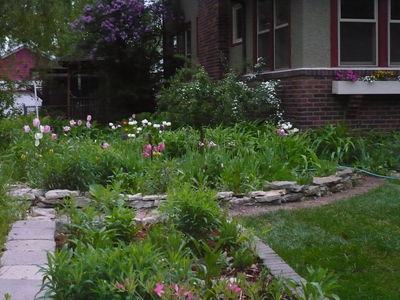
Difference between revisions of "Pollinator friendly Best Management Practices for stormwater management"
m |
m |
||
| Line 7: | Line 7: | ||
{{alert|Although the following links provide information on pollinator friendly practices, it is important to remember the primary function of a stormwater BMP is to manage stormwater. In particular, it is important to ensure that plants selected as being pollinator friendly must also function well within the stormwater practice. See [http://stormwater.pca.state.mn.us/index.php/Design_criteria_for_bioretention#Landscaping Design criteria for bioretention] and [http://stormwater.pca.state.mn.us/index.php/Minnesota_plant_lists Minnesota plant lists] for more information.|alert-warning}} | {{alert|Although the following links provide information on pollinator friendly practices, it is important to remember the primary function of a stormwater BMP is to manage stormwater. In particular, it is important to ensure that plants selected as being pollinator friendly must also function well within the stormwater practice. See [http://stormwater.pca.state.mn.us/index.php/Design_criteria_for_bioretention#Landscaping Design criteria for bioretention] and [http://stormwater.pca.state.mn.us/index.php/Minnesota_plant_lists Minnesota plant lists] for more information.|alert-warning}} | ||
| − | ==Pollinator friendly plants== | + | ===Pollinator friendly plants=== |
*[http://www.metroblooms.org/bloomsblog/planting-for-pollinators-how-raingardens-can-help/ Metro Blooms]: Planting for Pollinators: How Raingardens Can Help | *[http://www.metroblooms.org/bloomsblog/planting-for-pollinators-how-raingardens-can-help/ Metro Blooms]: Planting for Pollinators: How Raingardens Can Help | ||
*[http://www.xerces.org/wp-content/uploads/2014/03/GreatLakesPlantList_web.pdf The Xerces Society for Invertebrate Conservation]: Pollinator plants - Great Lakes Region | *[http://www.xerces.org/wp-content/uploads/2014/03/GreatLakesPlantList_web.pdf The Xerces Society for Invertebrate Conservation]: Pollinator plants - Great Lakes Region | ||
| Line 16: | Line 16: | ||
*[http://www.deeproot.com/blog/blog-entries/want-pollinators-plant-trees Deeproot]: Want Pollinators? Plant Trees | *[http://www.deeproot.com/blog/blog-entries/want-pollinators-plant-trees Deeproot]: Want Pollinators? Plant Trees | ||
| − | ==Pollinator friendly practices== | + | ===Pollinator friendly practices=== |
Although much of the information on these pages is general, many of the practices can be incorporated into vegetated stormwater BMPs. | Although much of the information on these pages is general, many of the practices can be incorporated into vegetated stormwater BMPs. | ||
*[http://www.fs.fed.us/wildflowers/pollinators/friendlypractices.shtml United States Department of Agriculture - Forest Service]: Pollinator Friendly Practices | *[http://www.fs.fed.us/wildflowers/pollinators/friendlypractices.shtml United States Department of Agriculture - Forest Service]: Pollinator Friendly Practices | ||
| Line 22: | Line 22: | ||
*[http://www.iatp.org/blog/201407/a-landowner%E2%80%99s-guide-to-pollinator-friendly-practices Institute for Agriculture and Trade Policy]: A landowner’s guide to pollinator-friendly practices | *[http://www.iatp.org/blog/201407/a-landowner%E2%80%99s-guide-to-pollinator-friendly-practices Institute for Agriculture and Trade Policy]: A landowner’s guide to pollinator-friendly practices | ||
| − | ==Case studies== | + | ===Case studies=== |
*[http://www.startribune.com/andover-garden-tour-is-a-pollinator-friendly-showcase/320641512/ Andover garden tour is a pollinator-friendly showcase] | *[http://www.startribune.com/andover-garden-tour-is-a-pollinator-friendly-showcase/320641512/ Andover garden tour is a pollinator-friendly showcase] | ||
*[https://pollinatorawareness.wordpress.com/ Andover Pollinator Awareness Project] | *[https://pollinatorawareness.wordpress.com/ Andover Pollinator Awareness Project] | ||
| Line 28: | Line 28: | ||
*[http://ento.psu.edu/pollinators/public-outreach/cert Penn State University]: Pollinator Garden Certification | *[http://ento.psu.edu/pollinators/public-outreach/cert Penn State University]: Pollinator Garden Certification | ||
| − | ==Other links== | + | ===Other links=== |
*[http://www.bwsr.state.mn.us/native_vegetation/Pollinator_Plan.pdf The Board of Water and Soil Resources] has a Pollinator Plan that includes why pollinator populations and habitat restoration matter, current protection and restoration efforts, native seed mixes, a fact sheet and a solar site pollinator habitat assessment form. | *[http://www.bwsr.state.mn.us/native_vegetation/Pollinator_Plan.pdf The Board of Water and Soil Resources] has a Pollinator Plan that includes why pollinator populations and habitat restoration matter, current protection and restoration efforts, native seed mixes, a fact sheet and a solar site pollinator habitat assessment form. | ||
*[http://www.xerces.org/pollinator-conservation/gardens/ The Xerces Society]: Targeted for gardeners, this site contains much useful general information on pollinators and managing for pollinators | *[http://www.xerces.org/pollinator-conservation/gardens/ The Xerces Society]: Targeted for gardeners, this site contains much useful general information on pollinators and managing for pollinators | ||
*[http://www.pollinatorfriendly.org/ Pollinator Friendly Alliance] | *[http://www.pollinatorfriendly.org/ Pollinator Friendly Alliance] | ||
Revision as of 15:32, 10 July 2017
An increasing focus on Green Infrastructure has brought an awareness that stormwater management can provide numerous benefits beyond improving water quality and urban hydrology. Trees, for example, provide a multitude of benefits beyond stormwater management, as discussed in this article. In particular, vegetated stormwater best management practices (BMPs), including tree-based systems and other bioretention systems, offer opportunities to achieve multiple benefits, ranging from aesthetics (see, for example, this presentation by Dr. Steven Rodie from the University of Nebraska - Omaha) to ecosystem friendly designs.
Vegetated stormwater BMPs can be designed to be pollinator-friendly. It is clear that pollinators, both vertebrates and invertebrates, are in decline (see [1], [2], [3], [4], [5]). This page provides numerous links to information that can be used in designing and implementing pollinator-friendly stormwater BMPs.
Pollinator friendly plants
- Metro Blooms: Planting for Pollinators: How Raingardens Can Help
- The Xerces Society for Invertebrate Conservation: Pollinator plants - Great Lakes Region
- Pollinator Partnership: Ecoregional Planting Guides
- United States Department of Agriculture - Forest Service: Attracting Pollinators to Your Garden Using Native Plants
- National Wildlife Federation: Plants for Pollinators: A Collection of Favorites
- Native Plants and Wildlife Gardens: Top Five Wetland Edge Plants For Pollinators
- Deeproot: Want Pollinators? Plant Trees
Pollinator friendly practices
Although much of the information on these pages is general, many of the practices can be incorporated into vegetated stormwater BMPs.
- United States Department of Agriculture - Forest Service: Pollinator Friendly Practices
- North American Pollinator Protection Campaign: Pollinator Friendly Practices
- Institute for Agriculture and Trade Policy: A landowner’s guide to pollinator-friendly practices
Case studies
- Andover garden tour is a pollinator-friendly showcase
- Andover Pollinator Awareness Project
- Penn State Extension
- Penn State University: Pollinator Garden Certification
Other links
- The Board of Water and Soil Resources has a Pollinator Plan that includes why pollinator populations and habitat restoration matter, current protection and restoration efforts, native seed mixes, a fact sheet and a solar site pollinator habitat assessment form.
- The Xerces Society: Targeted for gardeners, this site contains much useful general information on pollinators and managing for pollinators
- Pollinator Friendly Alliance
